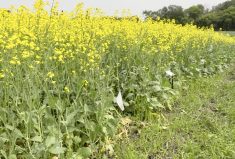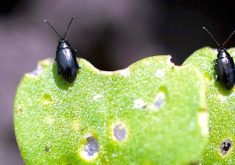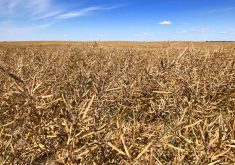Why would strictly grain, especially canola growers, be concerned over Bill 46, the Save Lake Winnipeg Act and the phosphorus regulation?
Spreading nutrients in winter significantly increases their movement into waterways during spring thaw and flood events in Manitoba.
Before 75 per cent of wetlands had been destroyed in agro- Manitoba, most excess nutrients were captured by wetlands.
Larger equipment and tracts of land have meant more drainage and the “need” to fall apply fertilizers. But, what grain producer applies chemical fertilizers to frozen land? How can they physically do it?
Read Also

Manitoba sclerotinia picture mixed for 2025
Variations in weather and crop development in this year’s Manitoba canola fields make blanket sclerotinia outlooks hard to pin down
Concentrating large numbers of animals (mostly hogs with the expansion of the industry) on a small land base resulted in rapid accumulation of phosphorus levels in soils around these factories. Many have now reached the regulatory limit, especially in the areas under the Bill 17 moratorium.
Instead of preventing expansion of industrial hog production, government promoted the industry and developed a phosphorus regulation that accommodates its polluting waste disposal (not crop fertilization) needs.
How can a regulation that allows 276 pounds per acre of phosphate to build up before there are any restrictions threaten grain producers’ livelihoods when, canola, on average, only uses 68 pounds per acre per year?
Even if more phosphate is applied than a cereal crop requires prior to planting a crop of canola, why would growers put on this amount of commercial phosphate?
After 276 lbs. per acre of soil test phosphate is reached, producers can apply double what a crop will use that year. Thus, phosphate levels can rapidly build to 823 pounds per acre, which is the regulatory limit.
What grain grower could afford to reach these excess levels with commercial fertilizers?
The hog industry is using the degradation of our land and lakes as a subsidy. Canola and grain growers would benefit more from withdrawing support to the hog industry, keeping their nutrient levels to what crops will use and calling for a lower limit in allowable phosphorus levels. Seems to me that is a safer and more economical approach for everybody other than intensive livestock operations.
Ruth Pryzner Alexander, Manitoba eerily similar. We are downstream of Pelican Lake. In the dry years, the “Pelican Lake Project” was conceived and built – ostensibly for the purpose of filling the lake. When the rains returned, this diversion scheme has served only one purpose, that of dumping water out of the lake.
This dumping is carried out in the sole and best interest of the cottage owners and the tourist industry, with no thought given to where this water will go and what it will do when it gets there or who will be hurt by it.
No consideration, financial or otherwise, has ever been given to those downstream who receive this liquid gift. The lake was opened in March of this year and only shut off June 10. That leaves us a total of 10 days for the water levels to recede, land to dry, weeds to be controlled and crop to be seeded. Good luck.
Now we all know that the needs of cottagers at play supersede the economic necessities of farmers paying their bills and trying to make a semblance of a living. I am under no illusion that common decency will prevail and that a solution in the form of less water or any compensation will be found.
I could go on for pages on the injustice of dumping your water problems on your downstream neighbours. Tell the ranchers and farmers in the Shellmouth area that I’ve been there and I’m still there and they have my sympathy and support. If they have received any financial support from the government, they are way ahead of my neighbours and me. Something has to change.
Garry Gillies Cartwright, Man.
Please forward letters to Manitoba Co-operator, 1666 Dublin Ave., Winnipeg, R3H 0H1 or Fax: 204-954-1422 or email: [email protected] (subject: To the editor)


















